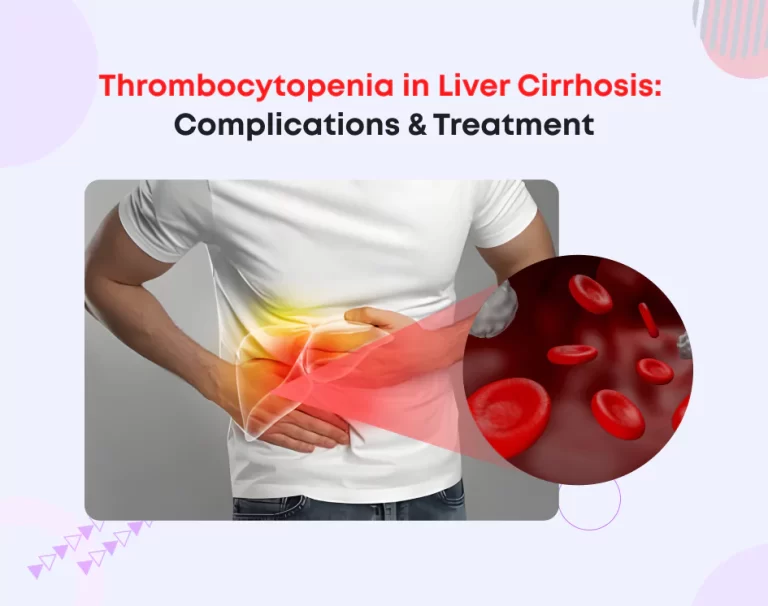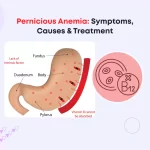
Thrombocytopenia in Liver Cirrhosis: Complications & Treatment
Liver cirrhosis is a severe condition that affects the liver’s normal functioning. It leads to scarring and liver damage over time. One of the common complications of liver cirrhosis is thrombocytopenia. It is a condition where the blood has an abnormally low number of platelets. Platelets are crucial for blood clotting, and their deficiency can lead to severe bleeding issues. This blog explores the complications associated with thrombocytopenia in liver cirrhosis and the available treatments. Understanding these aspects can help manage the condition better and improve the quality of life for those affected.
What is Liver Cirrhosis?
Liver cirrhosis results from long-term, ongoing damage to the liver. This damage causes scar tissue to replace healthy liver tissue. Scar tissue restricts blood flow through the liver and impairs its ability to process nutrients, hormones, drugs, and toxins. This condition can result from various causes, including chronic alcohol abuse, hepatitis B and C infections, and non-alcoholic fatty liver disease.
Symptoms of Liver Cirrhosis
- Fatigue
- Weakness
- Weight loss
- Jaundice (yellowing of the skin and eyes)
- Itching
- Swelling in the legs, ankles, or abdomen
- Easy bruising
Understanding liver cirrhosis is crucial for comprehending its complications, such as thrombocytopenia.
What is Thrombocytopenia?
Thrombocytopenia is when there are too few platelets in the blood. Platelets are tiny cells that assist with blood clotting. When the platelet count is low, it can lead to increased bleeding and bruising.
Symptoms of Thrombocytopenia
- Easy or excessive bruising
- Superficial bleeding into the skin
- Prolonged bleeding from cuts
- Bleeding gums or nose
- Blood in urine or stools
- Fatigue
Thrombocytopenia is particularly concerning in patients with liver cirrhosis due to the increased risk of bleeding complications.
Complications of Thrombocytopenia in Liver Cirrhosis
Thrombocytopenia in liver cirrhosis can lead to several severe complications. Knowing these complications is necessary to manage the condition effectively.
1. Increased Bleeding Risk
A low platelet count makes it harder for the blood to clot, leading to increased bleeding risks. Common bleeding issues are:
- Nosebleeds: Frequent and prolonged nosebleeds can occur.
- Gum Bleeding: Simple actions like brushing teeth can cause bleeding.
- Gastrointestinal Bleeding: There is a risk of bleeding in the digestive tract, which can be life-threatening.
- Surgical Complications: Increased bleeding during and after surgeries can occur.
Proper management and timely intervention are essential to prevent severe bleeding complications.
2. Anemia
Chronic bleeding due to thrombocytopenia can lead to anaemia, a condition where the blood lacks enough red blood cells. Symptoms of anaemia are:
- Fatigue and weakness
- Shortness of breath
- Dizziness
- Pale or yellowish skin
- Irregular heartbeats
Managing anaemia is crucial to maintaining the overall health and quality of life of patients with liver cirrhosis.
3. Hepatic Encephalopathy
Hepatic encephalopathy is a decline in brain function due to severe liver disease. It can be exacerbated by bleeding complications from thrombocytopenia. Symptoms of hepatic encephalopathy are:
- Confusion
- Altered level of consciousness
- Personality changes
- Mood swings
- Cognitive impairments
Preventing bleeding complications can help manage and reduce the risk of hepatic encephalopathy.
Treatment Options for Thrombocytopenia in Liver Cirrhosis
Effective management of thrombocytopenia in liver cirrhosis involves various treatment options. These treatments aim to increase platelet count, reduce bleeding risks, and improve the patient’s quality of life. Here they are:
Platelet Transfusion
Platelet transfusion is a common treatment to increase the platelet count in patients with severe thrombocytopenia.
Procedure:
- Platelets are collected from a donor.
- The collected platelets are then transfused into the patient’s bloodstream.
Benefits:
- Quick increase in platelet count.
- Immediate reduction in bleeding risk.
Platelet transfusions are often used before surgeries or invasive procedures to prevent excessive bleeding.
Medications
Several medications can help manage thrombocytopenia in liver cirrhosis.
Types of Medications:
- Thrombopoietin Receptor Agonists (TPO-RAs): These stimulate the bone marrow to produce more platelets.
- Corticosteroids: These can increase platelet counts by reducing the immune system’s destruction of platelets.
- Antifibrinolytic Agents: These help prevent the breakdown of blood clots.
Benefits:
- Medications can be used for long-term management.
- They help maintain a stable platelet count and reduce bleeding risks.
Regular monitoring and adjustment of medication are necessary for effective management.
Splenectomy
Splenectomy, the surgical removal of the spleen, is sometimes considered for patients with severe thrombocytopenia.
Procedure:
- The spleen is removed through surgery.
Benefits:
- Removing the spleen can increase the platelet count as the spleen is often involved in the destruction of platelets.
Risks:
- The risk of infection increases post-surgery.
- It is a major surgery with potential complications.
Splenectomy is considered when other treatments are ineffective.
Lifestyle Changes
Adopting certain lifestyle changes can help manage thrombocytopenia and improve overall health.
Recommended Changes:
- Healthy Diet: Eating a balanced and nutrient-rich diet supports overall health.
- Avoid Alcohol: Alcohol can further damage the liver and worsen thrombocytopenia.
- Regular Exercise: Light to moderate exercise can help maintain overall health.
- Avoid Injury: Be cautious to avoid cuts, bruises, and injuries, which can prevent bleeding complications.
Benefits:
- Lifestyle changes support treatment efforts and improve quality of life.
- They can help manage symptoms and reduce the risk of complications.
Incorporating these changes can complement medical treatments and support overall well-being.
Wrapping Up
Thrombocytopenia in liver cirrhosis presents significant challenges due to increased bleeding risks and associated complications. Knowing the condition and its complications is crucial for effective management. Treatments such as platelet transfusion, medications, and lifestyle changes can help manage thrombocytopenia and improve the quality of life for those affected. Regular monitoring and consultations with healthcare providers are essential to tailor treatments to individual needs. By addressing thrombocytopenia effectively, patients with liver cirrhosis can achieve better health outcomes and maintain a higher quality of life.








